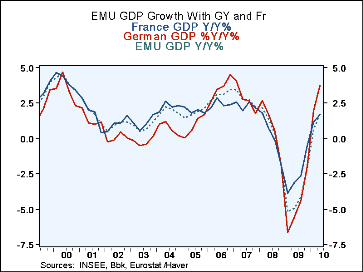 Global| Aug 13 2010
Global| Aug 13 2010German GDP Sends EMU Measure Flying....Is That Really Such Good News?
Summary
Europe surges - EMU GDP is advancing at a super-strong 3.9% rate (Saar) in Q2 leaving the US growth rate of 2.4% (and due to be revised lower...) in the dust. But at 3.2% the US Yr/Yr rate still towers over the EMU rate of 1.7%. But [...]
Europe surges - EMU GDP is advancing at a super-strong 3.9% rate (Saar) in Q2 leaving the US growth rate of 2.4% (and due to be revised lower...) in the dust. But at 3.2% the US Yr/Yr rate still towers over the EMU rate of 1.7%. But that rate is bested by Germany's 3.7% Yr/Yr as German quarterly growth surged by 9% (Q/Q Saar) the best figure Germany ever posted since re-unification.
Well, not all of Europe surges... While not all the EMU data are in and while GDP is just an aggregate with details as yet unavailable it is clear that EMU has a real problem with growth variation. Germany whose leader, Angela Merkel, drove hard for a no stimulus line at this year's economic summit, heads the country the most amazing growth rate in the quarter. Meanwhile, US growth is fading. Within the EMU growth rates across nations are erratic: rates sink as low as -5.8% for the quarter and -3.5% Yr/Yr both for Greece. So far Spain has dodged a bullet as it has its own austerity plans in gear but GDP rose by 0.2% (0.8% Saar) in Q1 and its Yr/Yr drop was cut to -0.1% from -1.3%.
Growth accelerated in four of the six EMU countries in the table plus in the UK, an EU member nation. In the US growth has decelerated. Japan has yet to report.
Still, one thing is clear, and this that trade is on an upswing. Although we lack Q2 data for most countries, through Q1 it was evident that import growth and export growth were coming back on line. Japan, whose export-to-GDP ratio had fallen by 30% in recession, has seen that ratio rebound by 30% though 2010-Q1. Most other countries are showing a sharp trade snap-back. With its trade figures for June showing an export set back, the US is the one fly in the ointment. While that is only a monthly number it is the first sign of weakness for trade in this quarter. The Euro-Area has just reported a big swing in its trade into surplus in June compared to May.
As we sort through the winners and losers and try to make sense of it all, one thing is clear and that is if the US economy is not doing well, Europe is going to be challenged. There are austerity plans in place in Europe and they did not bite in Q2 but Q3 and Q4 could find growth more at risk and trying to run uphill in relatively more economies. That will not be the time Europe will want to find out that foreign demand (i.e. the US) is slowing. When the details come out it will be interesting to see how much of this growth especially how much of Germany's rocket-like growth was home grown and how much of it piggybacked on the revival of domestic demand elsewhere.
Is Germany really contributing to growth or is it taking advantage of growth elsewhere? You have probably read the stories of German submarine sales to Greece around time that Greece's credit troubles were being publicized. Germany still completed its large weapons systems sales to its indebted and beleaguered neighbor. Let's wait to see the composition of growth before we start handing out medals for excellent performance. In the case of the US it is already clear that much of its domestic demand is being siphoned off overseas. Theses comments point up something we know and that is that little has changed to redress the structure of international balance of payments problems. The deficit countries are same old deficit countries and the BOP surplus countries are the same old surplus countries. These imbalances lay behind the development of the last financial crisis. What can I say? Here we go again?
Robert Brusca
AuthorMore in Author Profile »Robert A. Brusca is Chief Economist of Fact and Opinion Economics, a consulting firm he founded in Manhattan. He has been an economist on Wall Street for over 25 years. He has visited central banking and large institutional clients in over 30 countries in his career as an economist. Mr. Brusca was a Divisional Research Chief at the Federal Reserve Bank of NY (Chief of the International Financial markets Division), a Fed Watcher at Irving Trust and Chief Economist at Nikko Securities International. He is widely quoted and appears in various media. Mr. Brusca holds an MA and Ph.D. in economics from Michigan State University and a BA in Economics from the University of Michigan. His research pursues his strong interests in non aligned policy economics as well as international economics. FAO Economics’ research targets investors to assist them in making better investment decisions in stocks, bonds and in a variety of international assets. The company does not manage money and has no conflicts in giving economic advice.







